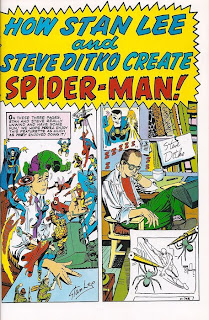Some of the questions I asked most frequently by kids (and often adults) involve working with artists as a writer. "Do you get to choose the artist who illustrates you story?" is one and "Do you and the artist work separately, or together?" is another.
The answer to both is "it depends."
Generally, the person I work with most closely is the editor. For most projects the editor will decide who will draw the story I've written. For example, some of the questions that might run through the editor's mind when choosing an artist are: How they choose the artist depends on a number of things. has the editor and artist worked well together on previous stories? Has the artist worked well with the writer on previous stories? has the artist drawn these particular characters before? Does their style fit the mood of the story? can they draw fast enough to meet the deadline for the story? Is this artist currently available to draw this story?
Most of the time, the editor will assign an artist to illustrate a story without even telling me who will be drawing it. This is how it is most often done on the various Cartoon Network titles I've worked on. For each of these titles, the editor will choose from a small group of artists who have demonstrated an outstanding ability to draw the characters and situations to reflect the look and feel of the television show that inspired them. If you look at the credits in several issues of SCOOBY-DOO, CARTOON NETWORK ACTION PACK, CARTOON NETWORK BLOCK PARTY, or any of the other titles, you'll see the same names appear over and over again. On these titles, we've all been working together for so long that we know that our combined efforts will come together in a fun story.
For other comic book projects I've written, the artist is usually assigned at the same time I am, and if I'm familiar with their work, I can write my script to showcase their strengths as an artist. For projects that I generate myself, I work with the editor in choosing an artist who is best suited for that particular project. In this case the editor and I will each come up with a list of artists we think would be good for the project and then decide on one we both like. If they are available, and like the project, they're hired. If we can't get them, we pick one of the other artists we liked.
One of the best part of writing comics is getting to work with so many different talented people, and seeing how they take my written scripts and translate them into illustrated stories. The finished result is always a surprise, even when you've worked with someone many times.
As to whether an artist and myself work together, or separately, it varies from project to project and from artist to artist. Most often, the artist and I will never meet, or even email each other until long after a project is finished. There are still so many people I've worked with, often for years, whom I've never met or even spoken too. We only know each other through our work together.
For some projects I will send the artist some reference material to help them. These can be photographs of locations featured in the story, or hand drawn maps I've made of how the characters should move through a location, or even sketches of new characters and creatures. All of this is done to make their job easier, and to help them get a better sense of what I imagined in my own mind when I wrote the story.
On a few occasions the artist and I worked very closely. We would talk on the phone several times a week. These conversations were often not about work at all, but simply us getting to know each other. This helped a lot. My scripts for these artists would get shorter over time, because so much of teh detail would get covered in conversation, and because I knew what movies or artists they liked, I could instruct them simply by comparing a scene in the script to a scene in a movie they'd seen, or a book they'd read, and say something like; "the house in this story should look something like the house in that movie," or "when the characters walk through these woods, the art should create the same feel as that part of that book where the characters were lost in a strange neighborhood." The artist will understand what I mean by this and it will help guide them when illustrating a scene in our project.
I've been really lucky. In all the years I've been writing comics, there have only been a couple of stories where I really didn't think the art fit the story well. Out of all the artists I've worked with, there have never been any whose work I haven't liked, and out of all of those that I've met, I'm friends with them all. I'm even friends with some I've only ever met through email.
I'm also happy to say that I've never had any real arguments with any artist I've worked with about how something should be done.
Below you can read a very tongue in cheek example of a comic book artist and writer working together. This was by writer, Stan Lee and artist, Steve Ditko about creating Spider-Man and comes from THE AMAZING SPIDER-MAN ANNUAL #1 from 1964.




that was the bestest with the mostest!
ReplyDelete